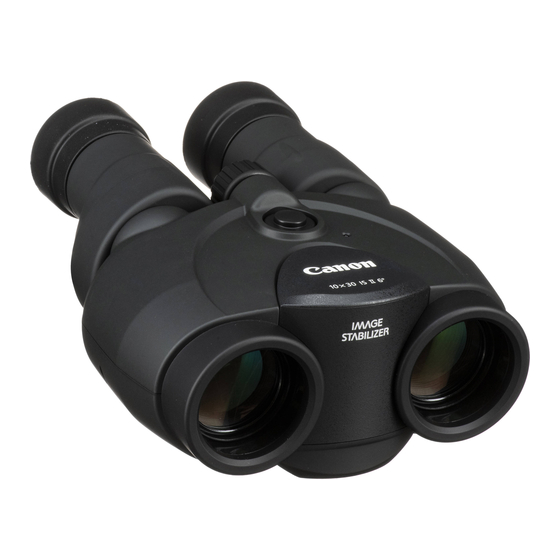Canon 10x30 IS II Folleto y especificaciones - Página 7
Navegue en línea o descargue pdf Folleto y especificaciones para Cámara digital Canon 10x30 IS II. Canon 10x30 IS II 8 páginas. Technology guide
También para Canon 10x30 IS II: Folleto y especificaciones (8 páginas), Manual del usuario (2 páginas), Manual (25 páginas), Manual de instrucciones (13 páginas)

Find the binoculars that fit your needs.
Waterproof and all weather
Lead-free optics
Several models in the Canon binocular
Canon uses environmentally friendly
line are waterproof or water-resistant.
lead-free glass in its optical systems.
Designed to be used outdoors and on the
This creates the high-quality
water, these models are built to withstand
performance you demand from your
a broad range of conditions including
binocular while protecting the
rain, humidity and more. The new Canon
environment from unnecessary harm.
10x42L IS WP offers Canon's highest
The importance of objective
standard of waterproof performance—it
can be completely submerged.
lens diameter
Binoculars are described by the power
of their magnification (18x, 15x, 12x,
etc.) combined with the diameter of their
more detailed images. So binoculars like
objective lenses (50mm, 42mm, 36mm,
the 10x42L IS WP, 18x50 IS AW and
etc.) The greater the magnification power,
15x50 IS AW produce particularly bright,
the larger your viewing subject will appear
clear images.
in the objective lens as you look through
The key to Field-of-View
the binoculars.
For instance, if you use the 10x42L IS WP
The field-of-view is the area you see when
to track a subject 100 yards away, it
you look through the binocular. The higher
appears to be the same size as a subject
the magnification power, the narrower the
located just 10 yards away seen without
field-of-view. The apparent angle-of-view
binoculars. All things being equal, the
is the product of the magnification times
larger the diameter of the objective lens,
the real field-of-view. So in the case of the
the more light it can admit for brighter,
10x42L IS WP, the 10x magnification with
100 yards away
with the naked
eye.
10 yards away with
the naked eye.
With a 10x magnification binocular,
the hot air balloon 100 yards away
will seem as if it were 10 yards away.
a 6.5˚ field-of-view appears to have a
Differences in brightness
65˚ range; qualifying it as a wide angle
instrument. The greater the apparent
angle-of-view, the easier it is for you to
pinpoint and track your subject. The
Canon binocular line offers models with
apparent angles-of-view that range from
45˚ to 67˚.
Canon's Super Spectra Multi Coating
The brightness of an image is associated
Looking through a 10x42L IS WP binoculars
at a subject 1,000 yards away
with the amount of incidental light that
is reflected by the lens. Uncoated lenses
can reflect away as much as 8% of
incoming light per lens element —
resulting in a dim image. For this reason
Canon employs Super Spectra Multi
c. Field-of-view at
b. Apparent
a. Real field-of-view: 6.5˚
Coating to enhance brightness.
1,000 yards: 340.6 feet
angle-of-view: 65˚
Since many things contribute to the
Wide field- of-view
brightness of an image, be sure to
consider the following factors as you
compare binoculars:
Exit pupil diameter
The size of the image that emerges at
the binocular's eyepiece impacts image
brightness. In dimly lit settings, a large
exit pupil, for example 4.2mm found on
the 10x42L IS WP, delivers brighter
Narrow field- of-view
results. For daytime viewing, binoculars
viewing is that higher magnification
with exit pupil sizes between 2.5 and
binoculars, even those with smaller exit
3mm are often sufficient.
pupil size or "relative brightness" ratings,
can often reveal better detail in low light
When bright....
because of their higher magnification.
Twilight Coefficient or Twilight Factor
accounts for the magnifying power of a
Viewer's pupil
pair of binoculars, and can be a useful
diameter is 3.0mm.
When dark....
rating—especially if viewing at dawn or
dusk, or deep shade viewing conditions.
Judging quality
Pupil dilates
as wide as 7.0mm.
When evaluating binoculars brands and
Objective element diameter
models, here are few things to look for:
This refers to the front lens element
Alignment
measured in mm. All things being equal,
If the parallel tubes of the binocular are
the larger the lens in front of the
out of alignment due to a manufacturing
binocular, the more light it can take in
defect or accident, you'll see two similar
and the brighter the viewing image will
but separate images. There is no way to
be. The 18x50 IS AW and 15x50 IS AW
repair this problem and it renders the
have the largest objective lenses in
binocular virtually useless.
Canon's binocular lineup.
Color
Twilight coefficient
Focus the binocular on a white object.
One difficulty with using traditional
Check two things: first, that the white
numerical ratings to determine a
object appears a faithful white tone
binocular's suitability for low-light
13
